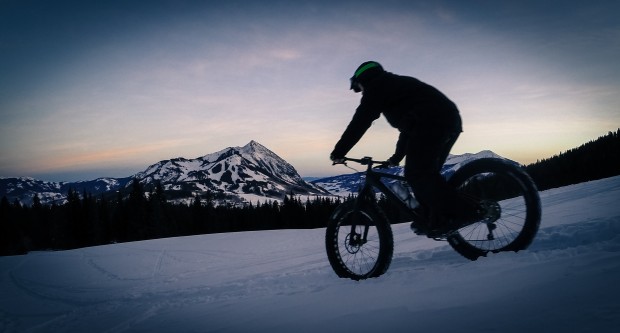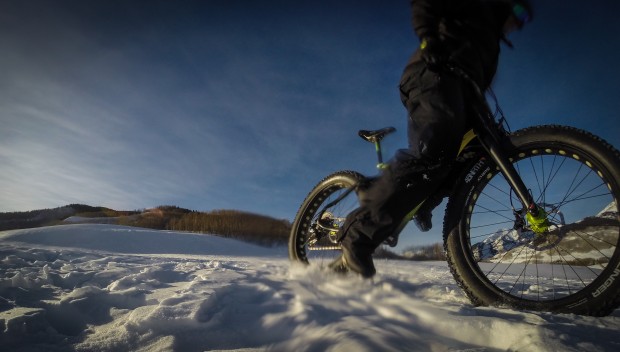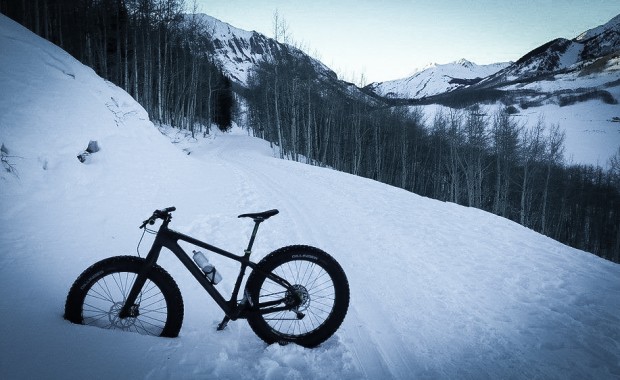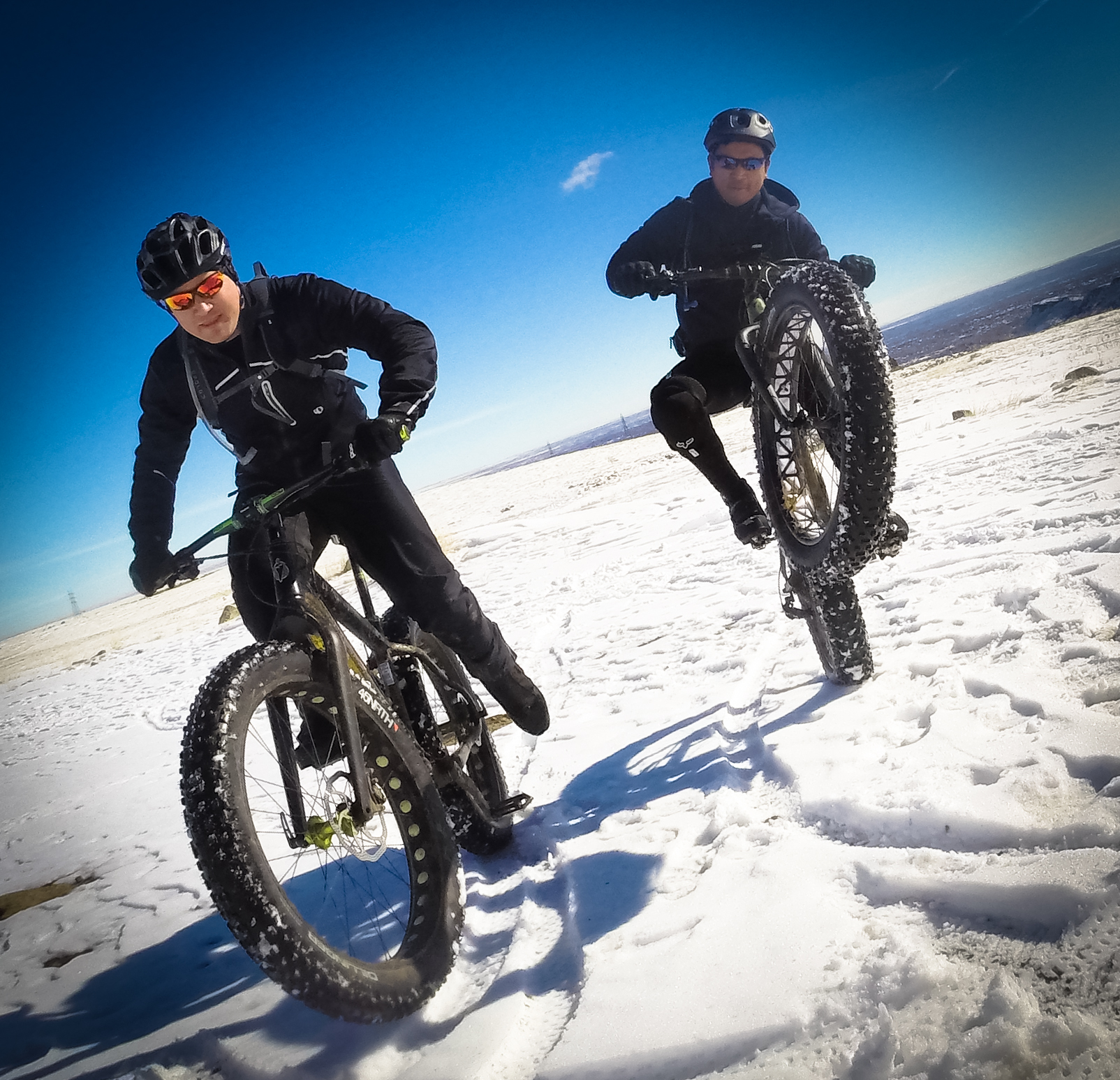Crested Butte just happens to be one of my favorite places to ride a mountain bike, particularly in the summer when the wildflowers blanket the tall green peaks with a rainbow of a colors. I would easily say that it is the most scenic place that I’ve ever ridden. With the official Crested Butte FAT Bike Race this Friday, January 31st, I wanted to check out first-hand what this famous, cozy ski town has to offer fat-bikers.

Not surprisingly, Crested Butte already has a lot of activities to do in the winter: skiing, snowboarding, snowmobiling, Nordic skiing, and snowshoeing, to name a few. Credited as one of the birthplaces of mountain biking, I was a little surprised, however, at how difficult it was for this seasonal tourist to find a place to ride my fat bike. Admittedly, I didn’t do any homework before I left, so I started by calling several bike shops once I arrived in town to get the low-down. Eager to try out the miles and miles of groomed Nordic trails around town, I was disappointed to learn that almost all of those trails are off limits to bikes, except for the Recreation “Rec” Trail. In all fairness, most Nordic ski trails in the US are off limits to bikes, but this information took me by surprise because a lot of these Nordic trails are the public singletrack trails, such as Lower Loop and the trails used for the race course this weekend. And this is Crested Butte, after all!

Instead, the bike shops directed me to check out Washington Gulch Road, Slate River Road, Gothic Road, and Snodgrass Trail. The first two did not seem to have much snow at all, so I added the last two to my list, in addition to the Rec Trail.
Snodgrass Trail
A popular trail in the summer, Snodgrass is gorgeous when it is covered in powder. Tall aspens line the trail and access road as you make your way slowly to the top. Finding the trailhead is easy: follow Highway 135 (Gothic Road) until you run out of asphalt. The remainder of Gothic Road is a dirt road in the summer, and is not maintained by the highway department in winter, so it becomes packed with lots of powder.

The first part of this trail is easy to negotiate if you stay on the packed sections made by skiers and hikers. After several hundred yards, there is a sign pointing forward to continue on the trail, or to the right to access Snodgrass Trail Road, packed by snowcats. I chose wisely to climb up the less-steep Snodgrass Trail Road, since it was late in the day and the snow was already a bit softer.
The forest was quiet and I did not encounter anyone the entire ride, stopping often to admire the overwhelming scale that is Crested Butte and take lots of photos. After an hour or so, I stopped at 10,400 feet of elevation (after 1,000 feet of climbing), and made the choice to return the same way I came, instead of the softer singletrack that winds through the forest back to the trailhead. It was a fast ride and took me less than 10 minutes to get back to where I started. Sweet.

Gothic Road
Anyone familiar with the sublime 401 Trail knows Gothic Road, and it is truly a majestic place to ride a fat bike in the winter. Parking at the trailhead that I mentioned earlier, simply continue onto the unmaintained part of Gothic Road to access this little white nugget.
This is an out-and-back route, so pedal until you’re tired then turn around. Keep in mind, however, that this road initially goes downhill several miles at first, so you’ll have a lot of climbing to do on the way out, but it is not steep and was rather easy even in softer powder. More importantly, the views here are incredible, as you travel into a valley dwarfed by 10-12,000-foot peaks. Despite being a popular route for skiers, I encountered virtually no one after a long day of snowboarding, and found it to be a place of quiet solitude and beauty… a great place to be and feel alone.

The Recreational “Rec” Path
This path is a little over two miles long and is groomed by the same folks who maintain the Nordic trails, but because it is public land, it is open to everyone. The path was designed to connect Mt. Crested Butte, where the resort and hotels are, with the town of Crested Butte, the place to get beer and coffee and souvenirs. In addition to the Nordic Trails that require a paid trail pass, there is also free Nordic system of loops on the southwest side of town. This seemed like a great place to ride a fat bike.

Since I was staying at a hotel near the ski lifts, I rode down the mountain to access the Rec Trail. The first part was melted and very sketchy, and I fell over several times as I floundered embarrassingly while trying to climb out of deep powder onto my bike in full view of adjacent traffic. After about 400 yards, however, the Rec Trail becomes groomed corduroy bliss, a fast decent into town. I kept going until I wound up behind the school, at a large, wooden sign that clearly delineated two trail systems: “paid” and “free.”

Based on this signage, and the complimentary trail map it offered, I genuinely assumed these “free” trails were open to everyone, so I rode them all, encountering only a handful of cross country skiers who seemed interested in my fat bike and encouraged me to keep riding. As I studied the map further, I realized that I had inadvertently taken a “paid” trail earlier, the 0.9-mile Teocalli connector trail, which connected the Rec Trail to the free Nordic trails. Since the Rec Trail only intersects a public road clearly marked “private,” I could not understand how to connect the Rec Trail and free trails without taking the Teocalli connector.

Nordic Trails
Later in the day, I inquired about this at the Nordic Center after deciding to rent cross skis with my family. The associate was polite, but his answer to my question stunned me. Apparently there is no way to connect them, and I was expected to just turn around at the end of the Rec Trail and head back up the hill, even though the Teocalli trail is also on public land, adjacent to the dirt jumps, as far as I can tell (locals, correct me if I’m wrong). The associate also made it pretty clear that the free Nordic trails were “really just for skiers,” and discouraged fat bike use, even though there was no signage indicating this.
Curious, I asked a few more questions about why fat bikes weren’t allowed on groomed trails (that are, again, singletrack in the summer). After all, it seems like a profitable venture, since fat bikes do not create much of a trail impact (my tracks were gone in the afternoon when I skied the same route). Again, I was stunned. He was very nice about it, but I was told that fat bikes would be “in the way,” and “what more do I want,” since fat bikes can already ride on roads and snowmobile trails (so can skiers), so stay off our Nordic trails.
Okeeedokey then. I guess that answers that. Sort of. He did semi-enthusiastically mention that they were considering making fat bike specific trails, but none were built yet.

Summary
I learned a few things on this trip that I would like to pass on if you want to fat bike Crested Butte:
- First, riding the narrow, sketchy hardpack is harder than riding on dirt because you really have to pay attention to where you are going. One wrong move and it’s a frustrating fall into waist-deep powder.
- Second, if you fall in powder, it is much easier to put your bike on the hardpack and use it to hoist yourself out.
- Third, it is best to ride early in the morning if it’s a bluebird day, when trails are hard and easier to ride on.
- Lastly, if you come to ski or snowboard Crested Butte, definitely bring or rent a fat bike! Riding before or after a day on the lifts is a great way to add to an already memorable ski trip and stretch out those sore muscles from a hard day on the bumps.
Parting Shots
I strongly believe in advocacy, and it is not my intention to paint the Nordic crowd in a bad light. I ski too. Understandably, Nordic skiers have to protect their trails, because they love them as much as mountain bikers love theirs. Fat biking is growing in popularity, but it is still relatively new in most of the lower 48, even in places like Crested Butte.
I am excited that events like the Crested Butte FAT Bike Race are happening there, on Nordic trails, because it opens the door for these sports to meet and support each other without encroaching on someone else’s turf. Part of the reason I wrote this article was to educate fellow fat bike riders, who like me are mostly tourists, to avoid riding Nordic trails (or ride the correct ones) and leave a favorable impression so that we can build our sport diplomatically over the years.
Honestly, in five years I fully expect to see full networks of fat bike trails, jump parks, and fat bike access to chair lifts at ski resorts for green/blue runs. I can’t wait. 🙂
Your Turn: What are your favorite places to ride fat bikes? Are fat bikes allowed on the Nordic trails near you?











3 Comments
Feb 2, 2014
Feb 2, 2014
The Butte was at the forefront of the mountain biking scene (as well as the extreme skiing scene). It would be awesome to see them set the pace in fat biking as well.
I like the picture of the tread on the cc ski trail. I've always wondered about fat bike trail impact and possible effects on the groomed cc ski surface and that pic makes it look negligible, just like bikes on singletrack in the summer.
Feb 3, 2014